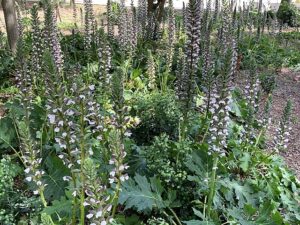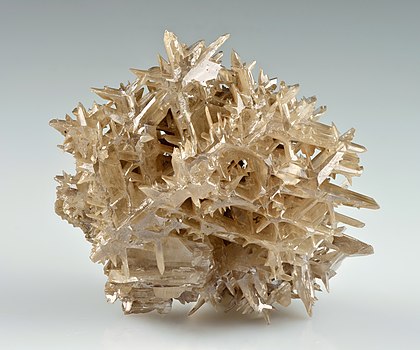
(Armenian bole, cont.) In this way, against a nosebleed: prepare bole with the juice of sanguinaria[3] and let him suck it with the nostrils and make a pledget and insert it in the nostrils, or powdered bole by itself can be inserted into the nostrils with a cotton wad. Or make a liquid substance of Armenian bole and sanguinary juice and he may suck it into the nostrils.[4]
A plaster can be made thus: prepare powdered bole with eggwhite and sanguinary juice, and place it on the temples when ready.
AKG
[3] Sanguinaria is identified in various ways in the glossaries. Lewis & Short calls it “an herb that stanches blood,” and provides the Greek, πολυγονον, polygonum, possibly Polygonum aviculare, or prostrate knotweed.
[4] Dittography?
Chap. 3 (f. 191r): Concerning Pomegranate flower
Pomegranate flower is cold and dry in the second degree. The fallen flower of a pomegranate is called “balaustia”; although the tree ought to produce fruit, its flowers clump together on a protuberance, and sometimes they fall from the tree, and sometimes they are consumed. They should be preserved with the outward parts removed, and they may then be kept for two years in full efficacy. The dried rind of pomegranate is called “psidia”[1], and the rind should be gathered when the fruit is ripe, the seeds discarded.
This is effective for everything that Armenian bole does, and further for choleric vomit and a flow from the belly from a weakness of retention.
In this way against choleric vomiting: grind the flowers and rind of pomegranate, cook them in vinegar, and put a sponge dipped in this on the fork of the collar bones.
Against a flux from the belly (i.e. diarrhea) from an inability to retain, in this way: let it be cooked in rain water and make a foment.
A powder of pomegranate flower binds together wounds.
Note that, instead of bole, powdered pomegranate flower may be used. But generally, as in all things for you, when one substance is put in a recipe, you should not use another in its place, if you can have it (i.e. the proper substance) in some way, since it will be less useful in medicine. Those things are most vigorous which are especially appropriate.
AKG
[1] Attested in Latham, 381.
Chap. 4 (f. 191r): Concerning Borage

Borage is warm and moist in the first degree. It is a common plant, having hairy leaves, which are better suited for medicinal use when they are fresh, not dried, the seeds secondarily. It has the effect of generating good blood.
For this reason it is helpful for those convalescing from sickness: it is helpful for those fainting, for the cardiac patient, for the melancholy, when eaten with flesh or seasoned with fat.
Against fainting there is such a use, from borage juice with sugar: make a syrup from its juice with sugar with ground bone of stag’s heart added in.
Against melancholy sickness and epilepsy, thus: let senna steep in borage juice, and in the strainings, make a syrup. If the plant is lacking, its seeds can be cooked in water, in whose strainings a syrup can be made. And note that the seeds can be kept for two years in great efficacy. The root is suited for medicinal use. The plant also, eaten raw, generates good blood.
Against jaundice, let it be eaten often cooked with meat, and a sufferer can use its juice and sowthistle in a beverage.
Chap. 5 (f. 191r): Concerning Parsnip
Parsnip is warm in the second degree and moist in the middle of the first. There are two kinds of this plant, that is, the domestic and the wild. Another name by which the plant is called is “pastinaca”. It is more suited for food than for medicine. It has the power of producing excess, thick blood. Thus, it increases the libido. It is more effective fresh, dried it is of no use.
For the convalescent and the melancholy, it is effective either raw or cooked, but fresh and not dried.
Let it be prepared with ginger for stimulating coitus; for soothing digestion, take the roots and cook them well in water, then cut them into bits and press out the water, and make medallions, to which is added skimmed honey and cooked until the honey is absorbed, stirring it constantly so that it doesn’t stick to the pot. In the midst of cooking, put in almonds if you have them, and cleaned pine-nuts if you have them. Aftereward, add aromatic spices, like ginger, galangal, a little pepper, nutmeg, and other well-scented spices.
AKG
Chap. 6 (f. 191r): Concerning Borax[1]
Borax is warm and dry in the fourth degree. It is, moreover, the gum of some tree that lives in overseas regions. In summer it flows in a pure viscosity, and it is condensed and hardened by the action of warmth. Something a bit impure also flows from it which is somewhat soft and full of dregs, as though of dirt. The borax that should be chosen is that which is white, clear, and hard, and if it has impurities, it should be discarded. It has the powers of cleansing, wiping away, and of attracting.
For clarifying the face and removing skin discoloration, and especially that which occurs after birth, and even if it comes about from hot air: a powder of borax may be prepared with rose water, and the face smeared with it.
For cleansing and purifying the face, women prepare it with honey and skimmed and strained eggwhite[2], and also with citron ointment.
They also prepare an ointment of chicken fat with pulverized borax and smear their faces with it.
Note that 3 scruples of borax may be put in 2 ounces of rosewater, 1 oz. of borax in 1 lb. of honey.
For stimulating the menses and a dead fetus and the afterbirth, a suppository may be made from borax and clary, well steeped in wine.
AKG
[1] In the Alphita, Borax is identified as “quedam gumma unde consolidatur aurum, anglice Boreis.” Ed. J.L.G. Mowat firther notes that it is “gummi idem, solidantur aurum et argentum.” P. 23, n. 12. Wikipedia notes:
A mixture of borax and ammonium chloride is used as a flux when welding iron and steel. It lowers the melting point of the unwanted iron oxide (scale), allowing it to run off. Borax is also used mixed with water as a flux when soldering jewelry metals such as gold or silver, where it allows the molten solder to wet the metal and flow evenly into the joint. https://en.wikipedia.org/wiki/Borax. Since borax has historically been used in the ways Platearius discusses, we must assume that he conflates the chemical substance with some unidentifiable plant product.
[2] In preparing eggwhite for suspending pigments or mixing into medicinal compounds, eggwhite was beaten until it was frothy and allowed to settle until the foam rose to the surface. Then the foam was skimmed off, the remaining liquid strained and, sometimes, thinned with water.
Chap. 7 (f. 191r): Concerning Betony
Betony is warm and dry in the third degree. Its leaves are especially suited for medicine, green and dried, and they are greatly effective. When simply betony is mentioned, its leaves are used.
For headache from a cold cause existing in it: make a gargle from a straining of a mixture of betony with stavesacre in vinegar.
If it comes from a vapor rising from the stomach[1], let wine with a decoction of betony be administered.
This is also effective against headache from a cause existing in the head.
Against stomachache, let a decoction of betony be given with the juice of absinthe, with warm water if there is serious constipation; in intestinal discomfort, after a clyster, this is also a remedy.
Likewise, for cleansing the womb while preserving the conceptus, make a foment from water with a betony decoction. Make a suppository as well, and let an electuary be given with powdered betony and honey.
AKG
[1] The word used here, anathamiasmi, must be a corruption of anathymiasis, a rising vapor.
Chap. 8 (f. 191r): Concerning Sandarac gum
Sandarac gum is warm and dry in the third degree. It is moreover the gum of some tree growing in overseas regions. In summertime, whatever gum flows out is hardened by the action of heat, and thus it is dried and called “bernix”.[1] There are three sorts of this: one is a yellowish color, another reddish, and another whitish. Whichever sort it is, only that which is clear and pure should be chosen. It has the power of binding from its gumminess, of clarifying and of preserving. This is clear enough since artists apply it over other colors so that they appear brighter, and it preserves the other colors. It can be kept a long time.
Of its use: it is useful against nosebleeds. Its powder, prepared with egg-white, should be applied to the temples and the forehead, and this is called “sinapisma”[2] since it comes about from gluing together. Its powder can be injected into the nostrils.
Against choleric vomiting: make a plaster from its powder and frankincense, in egg-white, and let it be applied to the collarbones.
The same may be done for dysentery, but with vinegar added, and applied on the pubes.
Its powder given with soft-boiled egg is effective against choleric vomiting and dysentery.
Its powder is also effective against interior and exterior rupture.
Salernitan women use its powder for clarifying the face. Note that “bernix” is the same thing as “cacabre”[3] and “ventosice”[4], but it is called bernix in Greek.
AKG
[1] Bernix = varnish. Sandarac gum was the sap of a small Moroccan tree named Tetraclinis articulata. It is the substance generally meant when the word varnish was used in the Middle Ages, and it was used to coat furniture and paintings with a clear, protective surface. See https://en.wikipedia.org/wiki/Sandarac.
[2] “Sinapisma” is defined as an “ointment spread on patient’s body, with medicinal powder sprinkled on it.” See Norri, 988.
[3] Latham identifies this simply as “gum,” at 62.
[4] Unknown.


































